 This interview is an excerpt from The WildLife with Laurel Neme, a program that explores the mysteries of the animal world through interviews with scientists and other wildlife investigators. “The WildLife” airs every Monday from 1-2 pm EST on WOMM-LP, 105.9 FM in Burlington, Vermont. You can livestream it at theradiator.org or download the podcast from iTunes, laurelneme.com or laurelneme.podbean.com. This interview is an excerpt from The WildLife with Laurel Neme, a program that explores the mysteries of the animal world through interviews with scientists and other wildlife investigators. “The WildLife” airs every Monday from 1-2 pm EST on WOMM-LP, 105.9 FM in Burlington, Vermont. You can livestream it at theradiator.org or download the podcast from iTunes, laurelneme.com or laurelneme.podbean.com.
Dr. Laurel A. Neme is also the author of ANIMAL INVESTIGATORS: How the World’s First Wildlife Forensics Lab is Solving Crimes and Saving Endangered Species. |
This interview originally aired on January 17, 2011. It was transcribed by Dustin Circe.
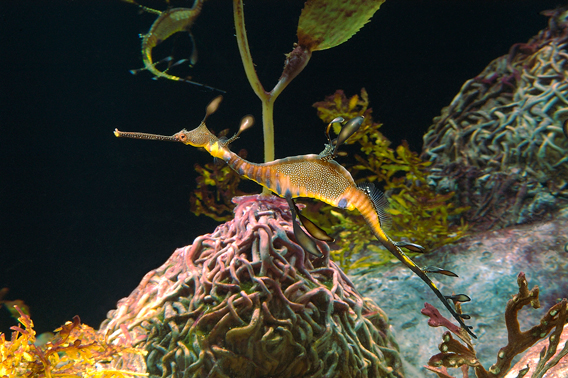
Weedy Seadragon. Picture by Todd Stailey of the Tennessee Aquarium in Chattanooga, TN.
Seahorses are strange looking creatures, with a horse’s head on top of a kangaroo’s pouched belly, bulging, swiveling chameleon eyes, a prehensile monkey tail, color-changing armor and a royal crown, all shrunk down to the size of a chess piece. To marine biologist Helen Scales, these elusive creatures are a perfect symbol of the ocean’s biodiversity.
Each of the seahorse’s odd characteristics serves an important function. With seahorses, the males bear the unborn young – so their kangaroo-like pouch provides the perfect place to incubate the eggs. Their long horse-like snouts are also well-designed for sucking in the tiny zooplankton that drift in the water column and are their main source of nutrition while their tails are perfect to grasp seagrasses so that they can lie in wait and ambush the tiny crustaceans as they float by. And, because they’re largely sedentary, their color-changing skin provides excellent camouflage.
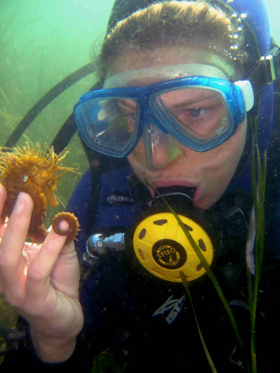 Dr Helen Scales and seahorse. Photo by Steve Trewhella |
There’s much we still don’t know about seahorses. For instance, scientists are not even sure how many different species exist. Over the past 200 years, 120 species were recognized, but many of those turned out to rename already named species. Part of the problem is that individual seahorses change color and grow skin filaments to camouflage themselves, and scientists don’t yet understand how habitat, locality, temperature or age affect these variations in color, size and form. Currently, there are somewhere around 35 recognized species of seahorses, but that number will likely increase as scientists learn more.
In the following interview, marine biologist Helen Scales, author of Poseidon’s Steed: The Story of Seahorses from Myth to Reality, describes the world of seahorses as she recounts their unusual anatomy and surprising sex lives. Helen Scales, PhD, is a marine biologist, writer, and broadcaster who specializes in fisheries, habitat protection, and the international trade in endangered species. She consults for a number of conservation groups, including the International Union for the Conservation of Nature, Natural England, and TRAFFIC International, and appears as a radio host on the BBC’s The Naked Scientists show and on BBC Radio 4’s Home Planet. She also produces and presents a new podcast series, Naked Oceans, a fun and informative exploration of the undersea realm.
SEAHORSE SPECIES
Laurel Neme: How many species of seahorses are there?
Helen Scales: That is a very good question. In fact, just today I was reading an article online about someone from South Africa who … confidently claimed that there were 80 species of seahorses, and I thought, “Oh, that’s a bit much.” There are different opinions about which species are true species and which ones are maybe split where they shouldn’t be. But generally what is agreed is that there are around 39 or 40 species of seahorses.
We’re still discovering new species. In the last few years, there have been a lot more pygmy seahorses that have been discovered. These are the tiniest seahorses, under an inch in height from the top of its head to the bottom of its unwound tail. It’s a really tiny creature so it’s no wonder they haven’t been found yet. But now with more scuba divers and photographers really scouring the coral reefs (because a lot of these tiny creatures are from the coral reefs), we’re finding more. There are more species out there to be found, so we will add to that list, but we’re looking at around 40 species at the moment.
SEAHORSE HABITAT
Laurel Neme: Where do they live?
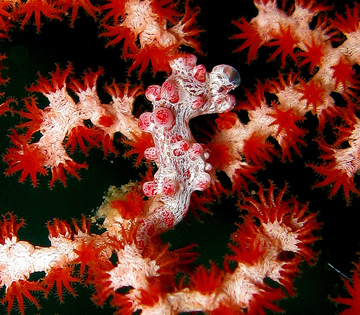 Nargibants seahorse. Photo by Stephen Childes |
Helen Scales: Originally I assumed that they all lived in the tropics in coral reefs. But in fact they live in temperate waters, too. You find them almost all the way through shallow seas apart from the very coldest frozen seas. The chances are, if you go to a piece of coastline, and your toes aren’t completely freezing when you dip them in the sea, you might see a seahorse. They live along most of the coastlines. They’re this cosmopolitan group that show up occasionally so that, if you look carefully enough, you’ll find them all over the world.
Laurel Neme: That’s different than the common assumption of them living only in coral reefs and tropical areas.
Helen Scales: Exactly. They have this reputation for being this wonderful exotic creature but they do live all the way through the oceans. For instance, Florida has its seahorses, and [you can find them] all the way up the eastern seaboard. I believe they’ve been showing up in Cape Cod, right up to Newfoundland, and down the South American coast to down into Brazil and further down south. Even in the southern coast of Australia, which is pretty cold water, you get seahorses along there. They don’t seem to mind being cold.
Laurel Neme: Do the types of seahorse vary depending where they are?
Helen Scales: Absolutely. Some of them have quite a wide range and some of them have a very small range. For example, the smallest range of any of the seahorses is called the Cape seahorse that only lives in three estuaries off the tip of South Africa. It is amazing but also quite worrying in that it means that they are highly vulnerable to any problems (e.g., changes to their coastal waters, pollution and so on) that might happen in that area.
We’re still learning more about the distribution of seahorses using techniques like DNA studies to unravel where the species boundaries lie—that is, where one species begins and another ends. Sometimes that’s very clear and sometimes it’s a little bit hazy.
Laurel Neme: What kind of habitat do they need?
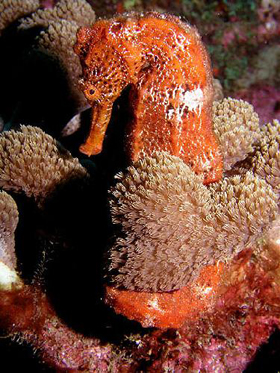 Seahorse in St Vincent. Photo by Kelly Graham of Marine Photobank |
Helen Scales: Coral reefs are one place that they live. Seagrasses are another really popular seahorse hang out. Generally, a seahorse needs something to hold on to. They don’t swim fast like most normal fish because they don’t have a big tail fin, the caudal fin that most fish have. [Instead,] they have this grasping tail, more like a monkey’s tail really, and they just hold onto things. They don’t swim very far generally. They are quite sedentary creatures. They like things like seagrass to hold on to. There are some species that live around mangroves. Mangroves are a great structural habitat for them to hold on to. There are even seahorses that take up residence in man-made structures like jetties, in marinas and places like that where there are underwater things for them to hold on to. [You might find them also in] sponge gardens or seaweed. All of these are popular seahorse places.
HOW BIG IS A SEAHORSE?
Laurel Neme: How big are they? What are the biggest and smallest seahorse species?
Helen Scales: The biggest is the Big-belly seahorse (Hippocampus abdominalis) from Australia. They are a foot long from head to tail. The smallest ones are these pygmy seahorses [there are nine species], which can be just infinitesimally small, less than an inch. They would stretch out on a penny; they are really tiny. On average, most seahorse species are around two or three inches long.
Laurel Neme: When you talk about their size, you’re talking about them stretched out. But they appear smaller because their tails curl up quite a bit.
Helen Scales: That’s right. Their bodies are always smaller than what we call the total length—that is, the head to tail length.
Laurel Neme: How do you identify them?
Helen Scales: If you want to identify one, there are many other measurements that will help you pin down which species it is, including: how long its snout is; its length; and whether it is stubby or long and slender?
You also get differences between species in head anatomy and also the size of its belly. Some are big bellied, like the Big-belly seahorse with its prominent belly even without pregnancy, and others are slightly more slender and less bulging. You get various themes on a seahorse. They are obviously all from the same mold. They have the same key characteristics but they vary in their overall morphology and shape.
SEAHORSE MORPHOLOGY
Laurel Neme: Why do seahorses look the way they do?
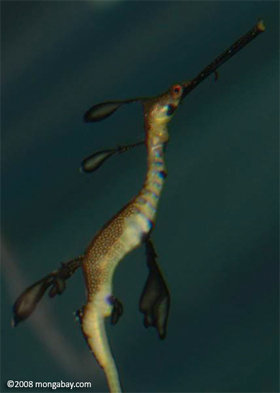 Sea dragon. Photo by Rhett A. Butler |
Helen Scales: We can all imagine the way an iconic seahorse looks. It’s almost a little bit like the knight on a chessboard, with a horse’s head that’s got that wonderful shaped curled over. Seahorses have the honor of being the only fish in the seas that have a neck, by which they have their heads bent over at roughly 90 degrees. Most fish have their head in line with their body, so they don’t really have that bent over neck. But seahorses do. That’s really what gives it its iconic horse shape.
They also have these big bulging cheeks. That’s where they breathe. That’s where their gills are. If you watch a seahorse, you’ll see that it puff its cheeks in and out. That’s it breathing. It breathes water in through its mouth and out through its gills. Its long snout we believe really is an adaptation for the kind of food that it eats.
Laurel Neme: What do seahorses eat?
Helen Scales: Seahorses eat mostly little creatures called zooplankton that live in the water column that drift through oceans, a bit like grass seeds going by on the air. Seahorses will pick out those little creatures and suck them down.
Laurel Neme: How does their shape help them feed?
Helen Scales: Feeding for a seahorse is a bit like eating your dinner through a drinking straw. They have these long snouts, and you might imagine that that’s a bit difficult and makes things harder. But, in fact, studies have shown that seahorses have the ideal shape of mouth for eating these tiny, tiny little creatures that flick around them in the water column. Seahorse can line up that snout with a tiny minute shrimp and then all of a sudden it sucks in a vortex of water through its mouth with those big cheeks, and the shrimp comes with it, and before it knows it, it’s become a seahorse snack. Studies show that the seahorses (and the pipefish, which are relatives of the seahorse and have a similar kind of snout), … have to go after the fastest prey, so they really have to be equipped with a very efficient way of feeding. That explains why they have that little horse’s head sort of shape.
They also have those wonderful swiveling eyes on their head, a bit like a chameleon, and they can look in more than one direction at the same time. Each eye can scan around so that they can stay still but look around them in the water to find some food. Again, it makes them very efficient at this “ambush” predatory way of eating.
Laurel Neme: What about seahorse fins?
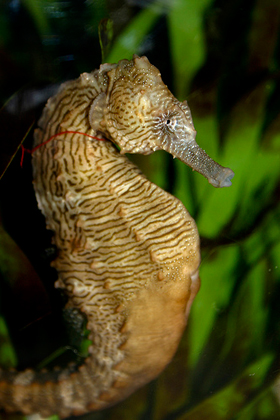 Lined seahorse. Photo by Brian Gratwicke |
Helen Scales: Seahorses don’t have the fins you normally see on a fish, [that is,] at least a couple of big fins to push itself through the water. Seahorses do have a couple of tiny transparent fins, but you have to look pretty carefully because they move them so quickly that they almost become invisible. They use these fins not for speed but for maneuverability.
Seahorses are the masters of being able to move through their environment in all three dimensions. They can move upwards, downwards, backwards, forwards, and really make use of that habitat. Then, once they’ve found something to hold on to they use that powerful tail, […which is] really very strong. A very important part of their lifestyle is being able to hold on through storms or waves or whatever comes along.
SEAHORSE LOCOMOTION
Laurel Neme: How do seahorses swim? They only have little stabilization type fins. Do they pump their tails to move?
Helen Scales: The tails don’t really help with propulsion. In fact, when they’re moving though the water, you’ll see they usually curl them up real tight, and then they use their little fins just to slowly push themselves through the water. The tiny fins are enough to propel them slowly. That’s really it.
Seahorses really must prefer not to swim. [Whey you see them in] aquariums, they’ll just hang on to whatever they can find. They’ll even hold onto each other if there’s nothing else to hold onto. I’ve seen sort of a cluster of seahorses all tangled up together, because they just seem to want to hold on. They don’t want to swim, because swimming for them is hard work. They will [swim] when they have to, but they prefer to stay put, I think.
Laurel Neme: [laughs] They’re sort of like couch potatoes?
Helen Scales: [laughs] Kind of.
SEAHORSE LIFESPAN
Laurel Neme: How long do they live?
Helen Scales: We are doing much better now at keeping them and studying them in captivity, and we’re looking at around about 5-10 years. It varies between species.
Life spans in the wild, they’re a bit more hazy. We don’t know so well. But a good friend of mine researches seahorses in Australia, and he tags them. He says there is one particular male that he has tagged, and he’s seen it for three years running hanging on to the same piece of coral. He really is not a cosmopolitan seahorse at all. He stays put. So you get a bit of an idea of how long they live for and how little they can move – which is really very crazy to think you can come back to the same spot and, three years later, see the same seahorse sitting there. But it’s kind of wonderful, I think.
SEAHORSE REPRODUCTION
Laurel Neme: What is the purpose of their big round bellies?
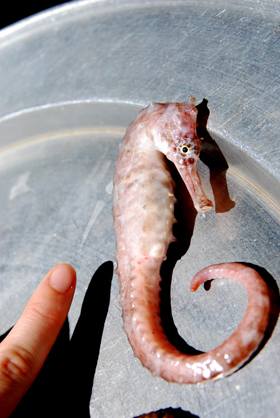 Dead Kellogg’s Seahorse. Photo by Helen Scales |
Helen Scales: The funniest, strangest part of the seahorse that leads us to an extraordinary part of their lives is this big round belly that they have. Like a kangaroo, they have a pouch in which the young are reared. It’s the males that have the pouches. It’s the men that get pregnant, not the girls. Seahorses are the only animal we have ever found throughout the animal kingdom in which this happens.
The female puts the eggs into the pouch. The male fertilizes them, and then he rears them as they grow up and his belly will grow bigger and bigger. If you see a big bellied seahorse from Australia when its pregnant it looks like a balloon that’s been inflated. It’s extraordinary how big they get.
At the end of the pregnancy the male will undergo what seems to be an arduous birthing process. The poor guys use that tail to hold on to whatever they can find to give themselves some perches, and they have contractions. Their pouches seem to contract and convulse and eventually the tiny baby seahorses will be expelled out into the water. They’re fully formed and they drift off and start their own lives somewhere else. Then the males get on right again with making more babies. It’s an arduous life being a male seahorse, I can imagine.
Laurel Neme: How long does pregnancy last?
Helen Scales: That’s a good question. I think it varies between species but, like I said, there’s so much we still don’t know about seahorses. We don’t know for all species just how long that gestation is. On average, it’ll last for a few weeks.
Laurel Neme: Do they form strong pair bonds?
Helen Scales: The really charming thing about seahorses is that, in a sense they are solitary but they do form these very strong pair bonds between a male and a female. Many seahorse species are monogamous for their entire lives. They will stay with the same partner. Once they’ve bonded, every morning male and female seahorses will come together and dance.
COURTSHIP AND DANCING
Laurel Neme: Are seahorses good dancers? What do the dances look like?
Helen Scales: They will dance these beautiful, mesmerizing courtship dances together. They twine their tails and spin round and round while [both] he male and female change their skin to different colors.
Laurel Neme: Do the colors mean something?
Helen Scales: Seahorses communicate they’re “in the mood” to each other with the changes of color, and the male makes little clicking sounds as well with the back of his head. This is how they reinforce their pair bonds. This will lead up to a mating with the male and female. If they think each other is okay, then they’ll mate.
Laurel Neme: What happens after mating?
Helen Scales: The female will then leave the male during the days. She goes off and has her own territory elsewhere. But every morning she’ll come back and find the male. At his stage, he usually is not really moving far. He stays put. The female comes back and they’ll dance again every morning. That reinforces this very strong relationship between the two of them. It’s really quite wonderful and it has an adaptation.
Laurel Neme: What’s the purpose of this dance?
Helen Scales: It’s not just [to be] romantic. This is nature; it has to happen for a reason, and the reason is, we think, a way for the female to assess how the male is doing: How is he getting on? Has he had his babies yet? Is he about ready to pop? Is it about time that I gave him some more eggs? Should I get my eggs ready? She’s assessing how he’s doing so that they, as soon as he’s had one load of babies, they can get straight down to it and start making some more — because that’s what [seahorse] life is all about.
Laurel Neme: Do the dances have certain forms? Is there a special “seahorse” dance?
Helen Scales: One thing that the males do that leads up to mating is that they seem to pump their tails up and down. It’s a very strange thing to see. Their tails stick straight out and they pump them and pump them. We think it’s possibly that he’s showing the female, in terms of having more babies: “I’m going to be really good at this, because this is what I’m going to have to do. I’m going to have to pump and squeeze and wriggle and, look I can do it. That’s his display of: “hey you know, I’m going to be a great dad, give me your eggs.”
FEMALE SEAHORSE ROLE
Laurel Neme: What role does the female play aside from providing eggs?
Helen Scales: That’s a good question. I guess that is her primary role. What seahorses have done, which no other animals have done, is to swap around which sex does the rearing. Normally it’s the female that rears the eggs once they’ve been fertilized. But it’s definitely the males that do it for seahorses.
In a sense, she has to spend her time eating so that she can produce lots of good eggs to pass on to the males. Once she’s done that, she doesn’t really have a role. She doesn’t help to feed him. She doesn’t protect him. She pretty much leaves him alone until it’s time for more eggs to be passed off. Really, that’s it. She’s an egg-producing creature.
SEXUAL DIMORPHISM…OR NOT
Laurel Neme: Do males and females look different?
Helen Scales: In some species not at all, [although] you can tell if a male is pregnant because he’s got his big belly…and even afterwards you can kind of tell there is a pouch there. In some species there is a bit of a size difference, so that some of the females are bigger. But [in seahorses] there is nothing like [the gender differences you see] in birds, [where] there are often really outlandish males and then quite drab females. That doesn’t happen in seahorses.
They don’t seem to have that sort of sexual dimorphism to attract the opposite sex. That doesn’t happen at all. I think they rely more on their courtship dance.
SEAHORSE MONOGAMY
Laurel Neme: Do you often see strong relationships?
Helen Scales: [Yes.] It’s really an amazing thing to see; these sorts of strong relationships between individual seahorses. There are a couple of species that are a bit more promiscuous; we can’t ignore that. There are some that live more in groups, and the females will actually mate with several males over the course of her life. But [even then,] for [each] one clutch of eggs that he has, he will only take eggs from one female.
Laurel Neme: So even the promiscuous seahorses are still monogamous for a little while.
Helen Scales: Absolutely. As far as we can tell, within each mating, a whole clutch of seahorses always comes from the same parents.
Laurel Neme: Do seahorses have preferences for certain kinds of mates?
Helen Scales: There have been studies showing what seahorses prefer. A year or so ago, there was a wonderful story that came out that male seahorses prefer bigger females. Size really does matter when it comes to a seahorse. The study showed that in some Australian species that have more social interactions and have more choice of mates, the males will go for a bigger female. That makes sense because she has probably got more resources within the same species. The bigger individuals are healthier. They’ve had more food. She’ll probably produce eggs that have lasted longer, and that have got more food and resources in the eggs themselves to grow bigger, because once those babies are out in the world, they’re going to have a tough time. They’re going to need all the help they can get. Like you said, no more help from mom and dad, so they have to sort of pack them off with as much food and energy as they can for those first few days when it can easily become food for something else in the oceans.
DAILY LIFE FOR A SEAHORSE
Laurel Neme: Are seahorse babies raised by their parents?
Helen Scales: No. They drift off. Life is tough for a seahorse. It has to figure it out for itself how to be seahorse. Sadly, they won’t all survive. It’s always that way in nature when you get hundreds, if not thousands, of babies and eggs produced. But enough do [survive] to hopefully keep the population going.
Laurel Neme: Are seahorses social?
Helen Scales: Studies show they don’t live in very great densities. That is probably part of the reason why they are hard to spot. Some species are moderately social and will live with a few in an area but many of them are solitary. In a section of seagrass bed the size of a tennis court, you might only find one or two seahorses. One piece of habitat doesn’t support that many seahorses. Even in a healthy population, they have to spread out and find their own territories.
Laurel Neme: What preys on baby seahorses?
Helen Scales: When they’re babies, they almost become part of the zooplankton. They’re so tiny that, when they drift around [at the beginning of their lives], they are one of the tiny creatures [in the water column] that fall prey to animals that pick at or filter the water for plankton. When they become adults, they do have some predators.
Laurel Neme: How do seahorses defend themselves?
Helen Scales: They tend to very well camouflaged. They have this skin that can change colors, so that they match their surroundings. They also have this outer layer of body armor. They don’t have scales but they do have overlapping bony plates that cover their bodies. That’s a really good protection for them. It makes them not good food. Seahorses are not great to eat. They’re a bit crunchy. There are not a huge number of predators that will take seahorses, but they have been found inside things like tuna and I’d imagine crabs. So, they do have their predators but they tend to hide pretty well from them.
MASTERS OF DISGUISE
Laurel Neme: Tell me more about seahorse camouflage. One reason why it’s been difficult to know how many species there are is that a number of species thought to be separate species were actually the same species. They were identified as separate species because of their different colors and shapes of their crowns. Seahorses seem so magical in that they can change their body’s appearance. What can a seahorse change?
Helen Scales: Seahorses have skin, not scales. That’s another strange seahorse fact. Most fish have scales but seahorses just have skin. And, in this skin, they have little cells filled with different colored pigment. They can expand or contract those cells, so that they can change the dominant color they’re putting out.
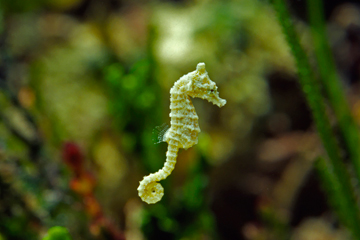 Dwarf Seahorse. Photo by Todd Stailey of the Tennessee Aquarium |
I don’t think we know an awful lot about how they control that, such as whether its hormonal. I think certainly some of that’s a nervous control, because it happens quickly for a couple during mating. They can flash different colors at each other. But, on a longer term, a seahorse wants to be able to really blend into its environment, into its background. So, they can change their color to become the color of seagrass. In fact, for people who keep seahorses in captivity, if you put a colorful background in the aquarium tank (e.g., a blue or a green background), they’ll match that too. Seahorses like to mimic what’s around them, whatever that may be.
Seahorses also have this ability to grow little filaments that sprout out of their skin. It’s still part of the seahorse. It’s a bit like growing our own hair, but those filaments help give them more of an appearance of a piece of weedy seaweed and also attract bits of stuff from the sea to stick on to them.
That’s why they’re masters of disguise – because they have this ability to change their texture as well as the color of their skin. That’s [also] why [it’s so difficult to do] taxonomy. When you’re identifying seahorses scientifically, it’s not recommended to use color too much because they can have different variations. Their color can depend on their mood. We still have some species that will have a particular range of colors that they tend to have, but it’s not a very reliable way of identifying seahorses because they really can change from day to day and from month to month.
Laurel Neme: Is changing texture as well as color rare for an animal?
Helen Scales: I think it’s a pretty rare and a pretty strange thing to be able to do. I think the octopus can do a similar thing. I’ve seen octopus bumping their skin up and making it rough and maybe smoothing it down … and obviously chameleons are another wonderful color changing creature. But changing texture, that’s a bit rare I’d say. Maybe it’s another special seahorse trait.
Laurel Neme: How do they change color? Is it a different mechanism than chameleons or octopus?
Helen Scales: I actually don’t know how chameleons do it but I think, on the whole, it is a similar. Again, I’m not too sure on the details of how they control and decide which colors to be, but I think it’s generally a case of having a layer of skin with these ink-like spots in it, which they can expose or cover up. Then by doing that, they can change the combination of colors and coverage of different colors and intensity of different colors. I think it’s similar but I’m not quite sure if they’re the same control mechanism.
Laurel Neme: It seems that seahorses adapt differently to different habitats.
Helen Scales: I would say that’s the success behind the seahorse model. The brilliance of it is they have the flexibility of tuning in to those different habitats. You’ve got seahorses that will camouflage themselves like sea fans or seagrass. … I think the key to a seahorse’s success is the ability to lead these quiet lives where no one really bothers you; you can just carry on with your seahorse life and make more seahorses and suck on plankton and that’s really all you need to be a seahorse, you just need quiet waters and to be left alone. That’s what they try, and they do it pretty well.
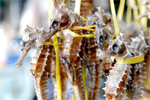
Seahorses under stress |
Related articles







